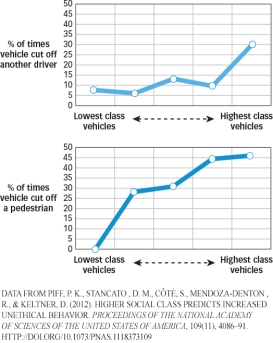Use the following to answer questions :
Scenario I
Scenario I is based on and presents data from the following study (reproduced from p.26 of the textbook) :
Piff,P.K. ,Stancato,D.M. ,Côté,S. ,Mendoza-Denton,R. ,& Keltner,D.(2012) .Higher social class predicts increased unethical behaviour.PNAS Proceedings of the National Academy of Sciences of the United States of America,109(11) ,4086-4091.doi:10.1073/pnas.1118373109
Piff and colleagues (2012) used naturalistic observation techniques to determine if wealthy people behaved more or less ethically than people who were not wealthy.In one study,observers stood at a busy intersection and recorded the make,model,and year of each approaching car.They also noted if the car cut off other cars or pedestrians at this intersection.
Major findings of Piff et al.(2012) are presented in Figure 1.1.This figure shows the percentage of times vehicles cut off another driver (top panel) or pedestrians (lower panel) as a function of the social status of the vehicles (with more expensive cars ranked higher in social status) .
Figure 1.1 
-(Scenario I) Based on the results shown in Figure 1.1,it is NOT known if:
Definitions:
Perpetual Inventory Method
An accounting approach that records inventory purchases and sales in real-time through direct changes in inventory and cost of goods sold accounts.
General Journal Entries
Recorded financial transactions that detail the exchange or transfer of value, representing the broader double-entry bookkeeping system.
F.O.B Destination
A shipping term indicating that the seller pays for transportation of the goods to the destination and retains ownership until delivery is completed.
Perpetual Inventory Method
An accounting method that records goods and materials inventory after every addition or subtraction, providing a continuous record of inventory levels.
Q61: Which of the following was NOT one
Q73: The tendency of people to remember words
Q80: The IQ correlation of identical twins raised
Q160: The term "belief bias" specifically refers to
Q165: Sir Frederick Bartlett's experiment showing how people
Q176: Morphemes are the smallest unit of sound
Q196: The "encoding station" for long-term declarative memory
Q227: Approximately,5 to 9 meaningful pieces of information
Q304: Ulrich Neisser's landmark book published in 1967
Q389: The functionalist approach was MOST influenced by